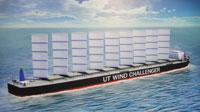 Early airplane wings were built of canvas stretched over a wooden frame, held together with wire rigging. Modern airplane wings are built of aluminum and other metals. The comparison to sails, masts and rigging on ships may not apply directly. Nevertheless, the last America’s Cup winner, the US-17, formerly known as the BMW Oracle Racing 90, screamed to victory in 2010, sailing on a 223 feet rigid wing sail, more than 80 percent larger than the wing of a Boeing 747 airplane. Now a Japanese group, including engineers from the University of Tokyo, are developing the design of a merchant ship with retracting rigid wing sails, the UT Wind Challenger.
Early airplane wings were built of canvas stretched over a wooden frame, held together with wire rigging. Modern airplane wings are built of aluminum and other metals. The comparison to sails, masts and rigging on ships may not apply directly. Nevertheless, the last America’s Cup winner, the US-17, formerly known as the BMW Oracle Racing 90, screamed to victory in 2010, sailing on a 223 feet rigid wing sail, more than 80 percent larger than the wing of a Boeing 747 airplane. Now a Japanese group, including engineers from the University of Tokyo, are developing the design of a merchant ship with retracting rigid wing sails, the UT Wind Challenger.
We recently posted about the efforts of B9 Shipping and Fairtransport to develop commercial sailing ships using an automated “Dynaship/Dyna-Rig,” similar to that used on the sailing yacht Maltese Falcon. The Dyna-Rig approximates the aerodynamic efficiency of a wing sail while still using cloth sails.
The UT Wind Challenger uses aluminum and reinforced plastic hollow wing sails. The UT Wind Challenger team has addressed a major problem with wing sails – that they are difficult to manage in port, by using what they refer to as “vertical reefing,” the wing sails retract into themselves. It appears that the UT wing sail design could be applied to considerably larger ships than is currently being planned for those ships using the Dyna-Rig. The developers estimate a 30% savings in fuel consumption using the wings sails, which sounds like a rather conservative estimate given the sail area involved. There are plans to build a reduced scale prototype to test the concept by around 2016.
Next generation cargo ship with 50m high sails uses 30% less fuel
